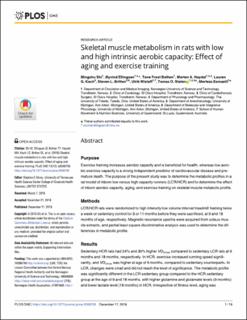| dc.description.abstract | Purpose
Exercise training increases aerobic capacity and is beneficial for health, whereas low aerobic exercise capacity is a strong independent predictor of cardiovascular disease and premature death. The purpose of the present study was to determine the metabolic profiles in a rat model of inborn low versus high capacity runners (LCR/HCR) and to determine the effect of inborn aerobic capacity, aging, and exercise training on skeletal muscle metabolic profile.
Methods
LCR/HCR rats were randomized to high intensity low volume interval treadmill training twice a week or sedentary control for 3 or 11 months before they were sacrificed, at 9 and 18 months of age, respectively. Magnetic resonance spectra were acquired from soleus muscle extracts, and partial least square discriminative analysis was used to determine the differences in metabolic profile.
Results
Sedentary HCR rats had 54% and 30% higher VO2max compared to sedentary LCR rats at 9 months and 18 months, respectively. In HCR, exercise increased running speed significantly, and VO2max was higher at age of 9 months, compared to sedentary counterparts. In LCR, changes were small and did not reach the level of significance. The metabolic profile was significantly different in the LCR sedentary group compared to the HCR sedentary group at the age of 9 and 18 months, with higher glutamine and glutamate levels (9 months) and lower lactate level (18 months) in HCR. Irrespective of fitness level, aging was associated with increased soleus muscle concentrations of glycerophosphocholine and glucose. Interval training did not influence metabolic profiles in LCR or HCR rats at any age.
Conclusion
Differences in inborn aerobic capacity gave the most marked contrasts in metabolic profile, there were also some changes with ageing. Low volume high intensity interval training twice a week had no detectable effect on metabolic profile. | en_US |

